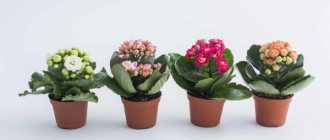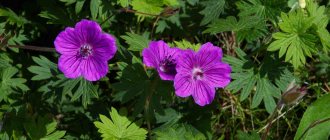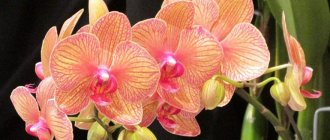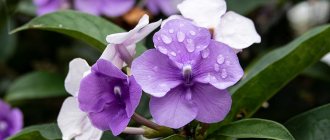Description of the plant
Along with other bromeliads, Guzmania has foliage whose bases overlap each other, creating a cup that the plant uses to store moisture. As a rule, guzmania foliage is monochromatic, but there are several varieties that have longitudinal or transverse stripes on the foliage. The length of the leaves can vary between 40-70 cm, and the average diameter of the leaf rosette is approximately 50-60 cm. Depending on the species, the length of the peduncle can also vary.
Guzmania mix begins to bloom from March to September and blooms for several months. Inconspicuous flowers, according to many gardeners, have an insufficiently decorative appearance, but are characterized by a fairly bright and glossy, red, yellow, white or orange colored bract. The height of an adult plant can reach 40-50 cm. A special feature is the death of the plant almost immediately after flowering.
Guzmania mix can be represented by a mixture of the following types of ornamental tropical crops:
- Donnell-Smith (G.donnell-smithii);
- Blood red (G.sanguinea);
- Mosaic (G.musaica);
- Lingular (G.lingulata);
- Nicaraguan (G.Nicaraguensi);
- Single-eared (G.monostachia);
- Tsana (G.azahnii).
Guzmanias, along with frisea plants, belong to the category of the most heat-loving bromeliad crops, so the ornamental plant must be cared for correctly, and care must be of high quality at all stages of growth and development.
Bloom
Store-bought young guzmanias usually bloom the same year. Small “real” flowers fade quickly. The bracts remain fresh and bright for much longer. Newcomers to floriculture do not know how often guzmania blooms. Each rosette blooms once.
If guzmania has faded, what should you do with the flower? The leaf rosette lives for about six months after flowering has finished. If a dried peduncle reduces the decorativeness of the guzmania, then it is cut off. During the last months of the rosette's life, side shoots grow at its base, which are separated and replanted. With good care they will bloom within a year.
Photo gallery
Reproduction at home
Reproduction of Guzmania mix is carried out after flowering, through lateral shoots called children. The flowering process causes the gradual death of the mother rosette and the formation of children, which, as they develop, build up their own root system. After the roots reach a length of one and a half centimeters, the shoot is separated from the parent plant using a sharp, sterile garden tool. Cuts on the parent plant are processed using a garden varnish. It should be remembered that the development of the root system on children does not occur simultaneously, and shoots must be planted gradually.
Guzmania can also be propagated by seed. In this case, it is necessary to prepare planting soil based on peat chips and medium-grained sand. The seeds of the decorative crop must first be washed in a solution of potassium permanganate and dried slightly. Sowing is carried out superficially, and then the planting container is covered with a transparent film. The temperature for seed germination should be maintained at 22-24ºC.
With regular spraying, seedlings appear in about a couple of weeks. After a couple of months, the seedlings are planted in nutrient soil based on leaf and turf soil with peat in a ratio of 2:1:4. Planting at a permanent growing site takes place after about six months.
Possible problems
If flower care is insufficient, the plant exhibits the following characteristics:
- when humidity is high, fungus develops;
- when there is a lot of sun, brown spots appear;
- dry air causes leaf tips to change color;
- yellow spots, cobwebs – signs of tick infestation;
- light fluff is a symptom of the appearance of a mealy worm;
- white tubercles are formed due to infection with scale insects;
- soft leaves (transparent in the light) are a sign of exposure to low temperatures.
The best varieties for home
If a florist has a desire to decorate their home with such exotic flowers, the first thing they start doing is choosing a variety. In nature, this plant is a fairly bright mix of colors, and in culture there are even more of them!
The most popular varieties of Guzmania are the following:
| Variety name | Description |
| Rondo reed Minor | A variety with white flowers that are beautifully set off by red stipules and dark green foliage. The plant has a short stem and compact size. The root system of the variety is very weak |
| Donell Smith | The plant's bright lemon flowers blend seamlessly with pale green foliage. The peduncle is elongated, with bright red stipules, pyramidal in shape. After flowering, it forms seeds that are used by breeders to create new varieties. |
| One-Eared Minor | A variety with yellowish-green leaves and a very bright peduncle with stipules streaked with brown or pink. |
| Mosaic Minor | A variety with decorative variegated leaves and a spreading rosette shape. The variety is distinguished by bright pink stipules and small pale yellow flowers. |
| Nicaraguan Tempo | The leaf blades of the variety are green, the peduncle is small, immersed in a rosette of leaves. Flowers reddish-orange, stipules bright red |
Flower lovers often prefer to grow red guzmanias, as they are believed to bring harmony in relationships into the home. Whether this is true or not, everyone can find out from their own experience. Fortunately, this flower does not require much effort.
Let's summarize
Thus, guzmania care is carried out taking into account the rules: high humidity is maintained from 60 to 80%, watering is controlled, since the leaves are additionally irrigated with water, and moisture accumulates in the rosettes. Use special soil and fertilizers.
It is important to replant shoots on time. Propagation by seeds is rarely done. This method is used when you need to take seed material of a plant you like, for example, from friends/acquaintances. If guzmania is chosen for cultivation, the varieties can be different - with flowers of different shades.
Home care rules
Growing guzmania mix is not too difficult, which makes it possible for novice gardeners to cultivate this indoor plant. Attention should be paid to temperature, humidity, watering and fertilizing.
Temperature and humidity
At the resting stage, indoor guzmania mix needs a temperature of 18-21°C. During the active growing season, including the flowering period, it is recommended to maintain the temperature within 22-24°C, which will allow the plant to bloom for three months. Tropical ornamental crops require a fairly high level of humidity, so the plant must be provided with regular moisture. In spring and summer, the aboveground part of the guzmania should be sprayed a couple of times a day with settled water at room temperature. In winter, foliar spraying is reduced to two to three times a week.
Watering and fertilizing
To irrigate the soil in a flower pot, only settled water at room temperature is used. A characteristic feature of epiphytic guzmania is the superficial location of rather tender roots, which are prone to rotting as a result of stagnation of water in the soil. In autumn and winter, watering should be very moderate, as the top layer of soil dries out. In the spring-summer period, irrigation activities are carried out once a day.
It is very important to remember that during the watering process it is necessary to fill the central funnel, which is formed by a leaf rosette, with water. It is recommended to feed exotic ornamental crops with a special mixture for bromeliad epiphytic plants. Fertilizers are applied a couple of times a month during the active growing season. The leaf rosette of an indoor ornamental plant is filled with fertilizer diluted with warm water.
Possible difficulties during cultivation
Although the process of growing Guzmania is not too difficult, there are some difficulties that arise in the process:
- Leaves wither. This may be due to stagnation of water in the outlet and will cause rotting of the roots. In this case, it would be appropriate to reduce the amount of watering.
- Flowering does not occur. The reason may be that the guzmania does not have enough lighting or, conversely, there is too much of it. Also, such a nuisance can be caused by an insufficient amount of nutrients in the soil and low air humidity in the room where the flower is kept. In order to stimulate flowering, it is recommended that after fertilizing, put bananas and apples in a pot with guzmania and cover it with a transparent film. Check the resulting still life to ensure that the fruit does not become moldy.
- Growth has slowed down .
This may be due to insufficient lighting and lack of nutrients in the soil. Did you know? For South Americans, guzmania is a symbol of male power. They also believe that the flower increases life expectancy and gives a person energy. - Rotting of the rosette and roots. This may indicate a local increase in moisture levels. To eliminate the problem, it is necessary to stop watering or replant the guzmania altogether.
- Curling leaves. The reason for this may be the appearance of insect pests such as spider mites, scale insects, and mealybugs. To get rid of them, you need to wipe the leaves with a sponge previously soaked in a solution made from laundry soap.
- Gray and black spots on leaves and trunk. May cause fungal infection. To get rid of this, spray the guzmania with a fungicidal solution.
In general, growing Guzmania should not cause much trouble, because with proper care it will bloom beautifully. This flower improves the home atmosphere and is a natural aphrodisiac, and therefore will be a wonderful and useful decoration for your home.
Tips and tricks
A mandatory event that must accompany the indoor cultivation of guzmania mix is the timely and competent transplantation of the exotic plant into a shallow flower pot filled with high-quality and well-drained substrate. A plant purchased at a flower shop also needs to be replanted after purchase. It is recommended to replant young ornamental crops annually, in early spring, before the indoor plant begins to flower. Adult plants can be replanted once every two or three years, in the spring and summer, with annual amendments or addition of substrate. Guzmania transplantation must be done extremely carefully and carefully, which is due to the presence of a very delicate and vulnerable root system in the plant.
Experienced amateur flower growers recommend cutting off flower stalks, since the ripening of seed material can inhibit the growth and development of new rosettes and shoots. A houseplant, due to the characteristics of its origin, can be affected by a number of pathogenic microflora.
Introduction
Guzmania is a tropical plant grown for its showy inflorescences. It is named after the Spanish biologist Anastasio Guzman. This epiphyte is very interesting for growing both for lovers of flower cultivation and for people experienced in this field.
It grows wild in India and Brazil. Novice flower growers believe that these representatives of the flora require a lot of time and attention. This is wrong. Although the apartment is nothing like its native tropics, Guzmania copes with this easily.
How to care for Guzmania at home? What needs to be done for sustainable growth? Let's take a closer look in the article.
How to separate Guzmania babies (video)
Guzmania mix quite often suffers from various fungal diseases , which are provoked by increased humidity and high room temperature. In addition, the ground part of Guzmania can be damaged by plant parasites common in indoor floriculture, such as scale insects, spider mites and mealybugs. When the first signs of damage are detected, treatment is carried out with modern insecto-fungicidal agents.
History of occurrence: what kind of species is this?
Orchids have a history of 130 million years. Species Mix is a fairly young representative of this family . Phalaenopsis Mix is a native of the Asian tropics, which was adapted by breeders more than 100 years ago for growing indoors.
The second name, phalaenopsis, is translated from Greek as “moth-like.” It appeared thanks to the director of the European Botanical Garden, Karl Blume. It was he who brought the original flower, the ancestor of the Mix species, to his greenhouse in the 19th century, captivated by its resemblance to a butterfly.











